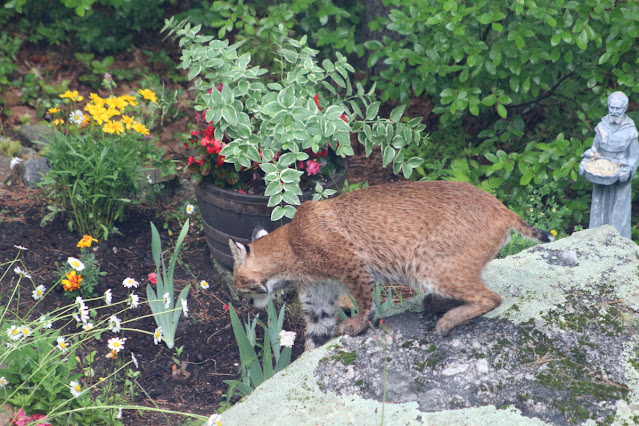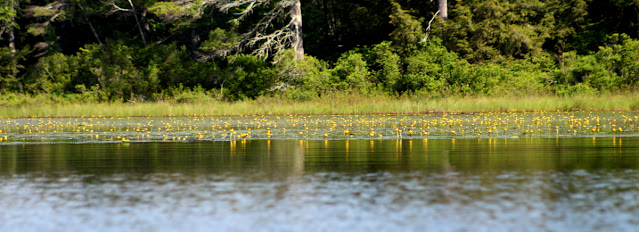I continue to receive word of bobcat sightings around Meredith, and this week, I had my own and it was a good one. One morning when I opened the shades, there was Mr. Bobcat standing proudly on a rock in Linda's garden, scanning his domain.
I say "Mister" because of its size - this is a big cat. Male bobcats weigh on average 27 pounds but can weigh over 40 pounds. Females' average weight is ten pounds less at 17 pounds. Furthermore, a female should be near her den taking care of her kits which should have been born in early May.
Not seeing anything of interest, he slunk off the rock to find a nice grassy spot for his morning grooming.
As still as I tried to stand, he knew something was there as he looked right at me at regular intervals.
Bobcats are ambush hunters, waiting quietly for their prey to amble by unaware, and he lay quietly grooming for a long time until suddenly his ears perked up and his neck rose high - I happened to be taking a video at that moment.
Now he was on the prowl.
Looking where he was heading, we saw the source of the sound - a medium size white-tail deer. But the deer saw us in the window, so we stood perfectly still, meaning that's the end of taking pictures. Now we watched with trepidation, not knowing what we were about to see. I know a bobcat can take down a deer - it jumps up on its back and delivers a powerful, fatal bite to the neck. But this usually occurs in winter when deer are slowed down by deep snow while the cat can sprint along on top of the snow with those large paws. Linda was thinking "I can't let this happen" but we just froze and watched.
The bobcat had stopped just at the edge of the road right across from the deer which was walking slowly down the road browsing on foliage along the way, frequently raising its head and staring right at us. Then it crossed the road right towards us - and the bobcat. I don't know what the trigger was, whether the cat moved or the deer glanced in that direction and saw it, but suddenly the deer lurched and bounded down the road. The cat sprinted out but realized there was no way it was going to catch a deer in full gallop. It stopped after two leaps, watching meals for at least a week bound down the road. It was an anticlimactic ending, but rather relieving for us too.
If you'd like to learn more about bobcats you can attend the Lake Wicwas Association Annual Meeting on August 7th at 9:30 am at the Wicwas Grange in Meredith Center. Patrick Tate, Wildlife Biologist for NH Fish and Game will provide a presentation on Bobcats in New Hampshire.
Now, some good loon-news after last week's sad story: both pairs have nested and are incubating, presumably, an egg or two.
Perhaps all the fighting with the rogue loon was keeping them from nesting, and now with the rogue loon out of the picture they got right to business. These two pairs do seem to have come to an undestanding about sharing the lake and where the dividing line is. Because it's so late in the breeding season I won't be surprised if each nest has only one egg, where normally a pair has two. But with a short season to raise chicks, having only one will let the parents provide twice the food and protection, increasing the chances of it being ready to fly off before the lake freezes over.
So, it's all good news in the world of nature. Except perhaps for the hungry feline that didn't get venison for dinner.






























.jpg)

a.JPG)










